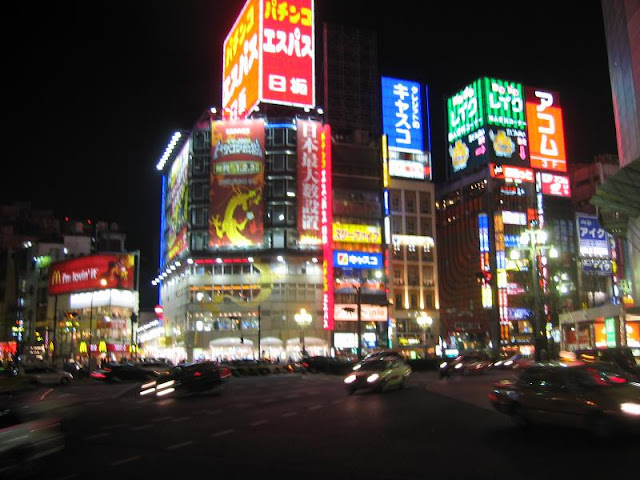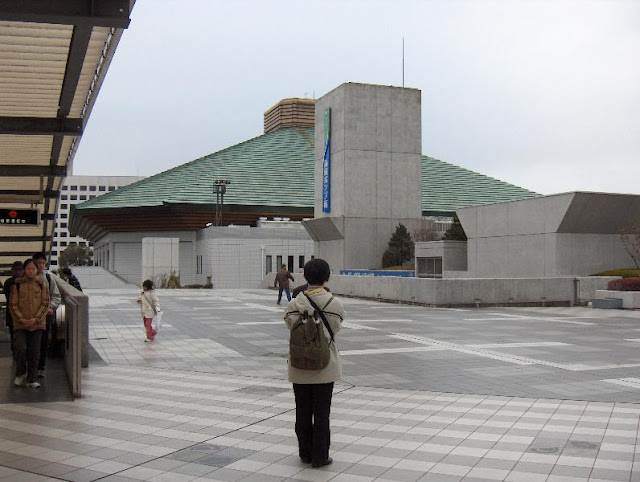Tokyo (東京, Tōkyō?, "Eastern Capital") [toːkjoː], English: /ˈtoʊki.oʊ/; officially Tokyo Metropolis (東京都, Tōkyō-to?), is one of the 47 prefectures of Japan. Tokyo is the capital of Japan, the center of the Greater Tokyo Area, and the largest metropolitan area of Japan. It is the seat of the Japanese government and the Imperial Palace, and the home of the Japanese Imperial Family. Tokyo is located in the Kantō region on the southeastern side of the main island Honshu and includes the Izu Islands and Ogasawara Islands. Tokyo Metropolis was formed in 1943 from the merger of the former Tokyo Prefecture (東京府, Tōkyō-fu?) and the city of Tokyo (東京市, Tōkyō-shi?).
Portion of city from the Tokyo Imperial Palace.
The Tokyo Metropolitan government administers the twenty-three special wards of Tokyo (each governed as a city), which cover the area that was the city of Tokyo, as well as 39 municipalities in the western part of the prefecture and the two outlying island chains. The population of the special wards is over 8 million people, with the total population of the prefecture exceeding 13 million. The prefecture is part of the world's most populous metropolitan area with upwards of 35 million people and the world's largest metropolitan economy with a GDP of US$1.479 trillion at purchasing power parity in 2008, ahead of New York City, which ranks second on the list. The city hosts 47 of the Fortune Global 500 companies.
Sakura in Tokyo Imperial Palace
Tokyo has been described as one of the three "command centers" for the world economy, along with New York City and London. This city is considered an alpha+ world city, listed by the GaWC's 2008 inventory and ranked third among global cities by Foreign Policy's 2010 Global Cities Index. In 2010 Tokyo was named the second most expensive city for expatriate employees, according to the Mercer and Economist Intelligence Unit cost-of-living surveys, and named the fourth Most Liveable City and the World’s Most Livable Megalopolis by the magazine Monocle. The Michelin Guide has awarded Tokyo by far the most Michelin stars of any city in the world. Tokyo hosted the 1964 Summer Olympics and is currently bidding to host the 2020 Summer Olympics
Panoramic view of Tokyo Imperial Palace as seen from Marunouchi
National parks
There are several national parks within Tokyo, among them:
² Meiji no Mori Takao Quasi-National Park, around Mount Takao to the south of Hachiōji
² Ogasawara National Park. As of 2006, efforts were being made to make Ogasawara National Park a UNESCO natural World Heritage Site.
² Ueno Park, well known for its museums: Tokyo National Museum, National Science Museum, Shitamachi Museum and National Museum for Western Art, among others. There are also art works and statues at several places in the park.
Panoramic view of Shinjuku and Mount Fuji taken from Bunkyo Civic Center
Seismicity
Tokyo was hit by powerful earthquakes in 1703, 1782, 1812, 1855, and 1923.[33][34] The 1923 earthquake, with an estimated magnitude of 8.3, killed 142,000 people. Tokyo is located near the boundary of three plates.
Tokyo National Museum, Ueno
Climate
The former city of Tokyo and the majority of mainland Tokyo lie in the humid subtropical climate zone (Köppen climate classification Cfa), with hot humid summers and generally mild winters with cool spells. The region, like much of Japan, experiences a one-month seasonal lag, with the warmest month being August, which averages 27.5 °C (81.5 °F), and the coolest month being January, averaging 6.0 °C (42.8 °F). Annual rainfall averages nearly 1,530 millimetres (60.2 in), with a wetter summer and a drier winter. Snowfall is sporadic, but does occur almost annually.[36] Tokyo also often sees typhoons each year, though few are strong. The last one to hit was Fitow in 2007.
From top left: Nishi-Shinjuku, Tokyo Tower, Rainbow Bridge, Shibuya, National Diet Building
Transportation
Tokyo, as the center of the Greater Tokyo Area, is Japan's largest domestic and international hub for rail, ground, and air transportation. Public transportation within Tokyo is dominated by an extensive network of clean and efficient[50] trains and subways run by a variety of operators, with buses, monorails and trams playing a secondary feeder role.
Within Ōta, one of the 23 special wards, Haneda Airport offers domestic and international flights. Outside Tokyo, Narita International Airport, in Chiba Prefecture, is the major gateway for international travelers to Japan and Japan's flag carrier Japan Airlines, All Nippon Airways, Delta Air Lines, and United Airlines all have a hub at this airport.
A map of Tokyo's 23 Special wards
Various islands governed by Tokyo have their own airports. Hachijōjima (Hachijojima Airport), Miyakejima (Miyakejima Airport), and Izu Ōshima (Oshima Airport) have services to Tokyo International and other airports.
Rail is the primary mode of transportation in Tokyo, which has the most extensive urban railway network in the world and an equally extensive network of surface lines. JR East operates Tokyo's largest railway network, including the Yamanote Line loop that circles the center of downtown Tokyo. Two organizations operate the subway network: the private Tokyo Metro and the governmental Tokyo Metropolitan Bureau of Transportation. The metropolitan government and private carriers operate bus routes. Local, regional, and national services are available, with major terminals at the giant railroad stations, including Tokyo, Shinagawa, and Shinjuku.
Fuji-Hakone-Izu National Park
Expressways link the capital to other points in the Greater Tokyo area, the Kantō region, and the islands of Kyūshū and Shikoku.
Other transportation includes taxis operating in the special wards and the cities and towns. Also long-distance ferries serve the islands of Tokyo and carry passengers and cargo to domestic and foreign ports.
Tokyo Stock Exchange
Culture
Tokyo has many museums. In Ueno Park, there is the Tokyo National Museum, the country's largest museum and specializing in traditional Japanese art; the National Museum of Western Art; the National Museum of Science and Ueno Zoo. Other museums include the Nezu Art Museum in Aoyama; the Edo-Tokyo Museum in Sumida, across the Sumida River from the center of Tokyo; and the National Diet Library, National Archives, and the National Museum of Modern Art, which are near the Imperial Palace.
Tokyo has many theaters for performing arts. These include national and private theaters for traditional forms of Japanese drama (such as noh and kabuki) as well as modern drama. Symphony orchestras and other musical organizations perform modern and traditional music. Tokyo also hosts modern Japanese and international pop and rock music at venues ranging in size from intimate clubs to internationally-known arenas such as the Nippon Budokan.
Shiodome City Center in Minato, headquarters of All Nippon Airways and Fujitsu
Many different festivals occur throughout Tokyo. Major events include the Sannō at Hie Shrine, the Sanja at Asakusa Shrine, and the biennial Kanda Festivals. The last features a parade with elaborately decorated floats and thousands of people. Annually on the last Saturday of July, an enormous fireworks display over the Sumida River attracts over a million viewers. Once cherry blossoms, or sakura, bloom in spring, many residents gather in Ueno Park, Inokashira Park, and the Shinjuku Gyoen National Garden for picnics under the blossoms.
Mitsubishi Corporation headquarters in Marunouchi, Chiyoda
Harajuku, a neighborhood in Shibuya, is known internationally for its youth style, fashion and cosplay.
Cuisine in Tokyo is internationally acclaimed. In November 2007, Michelin released their guide for fine dining in Tokyo, awarding 191 stars in total, or about twice as many as Tokyo's nearest competitor, Paris. Eight establishments were awarded the maximum of three stars (Paris has 10), 25 received two stars, and 117 earned one star. Of the eight top-rated restaurants, three offer traditional Japanese fine dining, two are sushi houses and three serve French cuisine.
Map of Tokyo Subway system
University of Tokyo, Yasuda Auditorium
Waseda University
Keio University
Tokyo Dome, the home stadium for the Yomiuri Giants
Yoyogi Fountain
A big fountain in Yoyogi sprays water into the air.
Walking Down Sidewalk
A pictures of me walking down a sidewalk in Tokyo
Tokyo Waterfront
Along the waterfront in Tokyo as it starts to get dark
Tokyo Water Shuttle
A shuttle in Tokyo carries people through the waters of Tokyo Bay
Tokyo Traffic
Some traffic in Tokyo driving on the left side of the road
Tokyo Statue of Liberty
The Tokyo Statue of Liberty with the bay and Rainbow Bridge in the background
Tokyo Reflective Building
Can't remember where this is from.
Tokyo Park
Looking towards the Tokyo Dome and a view other big buildings
Tokyo Loop
A loop of stop lights that runs around the intersection in Shinjuku
Tokyo Lights
Lots of lights in Tokyo at night
Tokyo Vending Machine
A vending machine in Tokyo selling drinks. There are lots of vending machine on the roads in Tokyo
Tokyo Sports Arena
A sports arena in Tokyo home to WWE matches, sumo wrestling and more
Meiji Shrine
Lots of people pray at Meiji Shrine. They usually throw a coin into the well after making a prayer
Meiji Park
The giant entrance to Meiji Park, an area near Shibuya
Meiji Park Wall
An artistic wall at Meiji Park
Kids Shopping
A few kids shopping at an electronics store in Akihabara. There was a lot of really cool stuff in this store; from massage chairs to pianos, this store had it all
Japanese Night
Lots of lights and a bit of traffic at night at the intersection in Tokyo
 01:57
01:57
 homesweethome
homesweethome












































 Posted in:
Posted in: 








0 意見:
Post a Comment